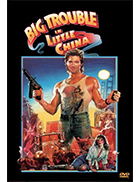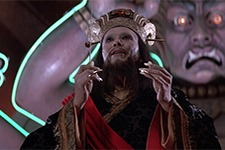| Director: John Carpenter | | Screenplay: Gary Goldman & David Z. Weinstein (adaptation by W.D. Richter) | | Stars: Kurt Russell (Jack Burton), Kim Cattrall (Gracie Law), Dennis Dun (Wang Chi), James Hong (David Lo Pan), Victor Wong (Egg Shen), Kate Burton (Margo), Donald Li (Eddie Lee), Suzee Pai (Miao Yin) | | MPAA Rating: PG-13 | | Year of Release: 1986 | | Country: U.S. |  |
|  When John Carpenter’s Big Trouble in Little China was released theatrically in 1986, neither critics nor audiences knew what it do with it. Its bizarre, self-reflexive combination of the traditional Western action-adventure movie with creature features, gang movies, ghost stories, slapstick comedy, and a blend of Chinese kung-fu and mysticism with the style of Japanese anime was simply confounding, and the result was, therefore, not surprising: Critics panned it, audiences didn’t go see it, and the movie flopped. Since then, it has gained a cult following on video, and re-viewing it 15 years later, one gains a better appreciation for what Carpenter was trying to achieve. The movie was and still is a narrative mess, but it is an immensely enjoyable mess, one whose sheer energy and inventiveness outweighs its numerous flaws. A postmodern exercise in genre and style blending, Big Trouble in Little China is a purposeful mishmash-hybrid of often conflicting elements that somehow comes together into a creative and utterly unique whole. I don’t think Big Trouble is a “good movie” in the traditional sense, but in this case that is a good thing because part of the movie’s fun is the way it snubs its nose at tradition, both Western and Eastern. Kurt Russell, in his fourth outing with Carpenter after the TV movie Elvis (1979), Escape From New York (1981), and The Thing (1982), stars as Jack Burton, a shaggy, smug, overconfident truck driver who gets embroiled in a heap of trouble in and beneath San Francisco’s Chinatown. It all starts when Miao Yin (Suzee Pai), the fiancé of his poker buddy Wang (Dennis Dun), is kidnapped by a members of a street gang. It turns out that Miao Yin has been taken by Lo Pan (James Hong), a 2,000-year-old sorcerer-spirit who needs to marry and then kill her in order to become flesh again. Lo Pan is aided by “The Three Storms,” a trio of supernatural warriors who appear from time to time riding bolts of lightning or flying through the air. That is just the tip of the proverbial iceberg, of course. Also involved is Gracie Law (Kim Cattrall), a nosy lawyer who, because she is the complete opposite of Jack (where he is thoughtless and gung-ho, she is measured and organized, though not lacking in spirit), is destined to become his love interest. In tow with Gracie is Margo (Kate Burton), a burgeoning journalist who has her eyes opened wide by the events that transpire in the subterranean world beneath Chinatown. Describing the plot of Big Trouble in Little China is ultimately an exercise in futility because the movie is not about its plot. The plot, which is essentially a contrived series of chases, escapes, and rescues, serves only as a convenient excuse for the staging of elaborate action sequences in weird, highly stylized settings. Carpenter is a good action director, and he manages to stage exciting sequences with a great deal of fast-cut editing without letting it devolve into utter chaos. Most of the action takes place in Lo Pan’s underground lair, which is a neo-Oriental concoction of ancient furnishings (lots of Buddhist statues), dank dungeons, and neon lighting, all of which is surrounded by a swamp-like area known as “The Bog of the Dead Trees.” What makes Big Trouble in Little China stand out from most action movies of the mid-1980s is not only its visual inventiveness, but also its willingness to put at the center of the story a not-so-heroic hero who is a direct counterpoint to the Rocky-Rambo theatrics of the Reagan era. Kurt Russell is a kind of everyman’s action hero, a no-nonsense, blue-collar trucker (his truck is nicknamed “The Pork Chop Express”) who acts and speaks before he thinks, yet always manages to slip out of the trouble he gets himself into. He is not so much brave as he is bull-headed, and it shows in his actions and his self-concept, especially in how he speaks of himself constantly in the third person (“Well, you know what ol’ Jack Burton says in these situations...”). Russell’s character is indicative of Carpenter’s whole approach to the movie, which is one of lighthearted excess and a refusal to take anything too seriously. He uses Jack Burton comically as a way to bring ordinary skepticism into a fantastical story. Most fantasy stories simply ask you to accept everything they put on-screen, no matter how outlandish. There is plenty of outlandishness in Big Trouble in Little China, and Jack is always on hand to question and doubt everything, only to be put in his place by someone whose knows what is really going on. At one point, when traveling through the underground caverns beneath Chinatown, the movie’s good sorcerer, Egg Shen (Victor Wong), notes that the liquid flowing in the river below them is “the black blood of the earth.” “You mean oil,” Jack says assuredly, thinking he is correcting the old man’s outdated English. “No,” Egg replies. “I mean black blood of the earth.” And that’s the kind of movie Big Trouble in Little China is. Where others see oil, it sees black blood of the earth. It throws wild ideas at you and literally laughs at your skepticism, just as it does at Jack’s. The second you start thinking about it, the movie bogs down and simply becomes ridiculous. But, if you allow yourself to sink into its bizarre subterranean world without pause or questions, it’s a fun ride. | Big Trouble in Little China Special Edition Two-Disc DVD Set | | | Aspect Ratio | 2.35:1 | | Audio | English Dolby Digital 4.1 surroundEnglish DTS 4.1 surroundFrench Dolby 2.0 stereo | | Subtitles | English, Spanish, French | | Supplements | Audio commentary with director John Carpenter and actor Kurt RussellBehind-the-scenes featuretteDeleted scenesExtended endingInterview with visual effects supervisor Richard EdlundStill galleryTwo interactive magazine articles“Big Trouble in Little China” music videoThree theatrical trailersSix TV spotsProduction notes from 1986 press kitCast and crew biographies | | Distributor | 20th Century Fox Home Entertainment | | SRP | $26.98 | | | COMMENTS | | Presented in a new anamorphic widescreen (2.35:1) transfer, Big Trouble in Little China looks great, much better than either the old pan-and-scan video copies or the widescreen laser disc. The visual quality on this disc is as good as I can imagine it being, which allows you see the movie in a whole new light. A great deal of effort went into the sets, costumes, and special effects on this film, and the sharp, detailed image and vibrant colors really makes them stand out. Contrast and black levels look good throughout, as well, which brings new life to dark scenes that had previously looked too murky (for a good comparison, watch the behind-the-scenes featurette and compare the image quality of the included movie sequences in it with the same sequences in the movie itself). The soundtrack is available in either Dolby Digital 4.1 or DTS 4.1 surround, which are essentially 5.1-channel mixes except that the two surround channels are not discreet. Both soundtracks sound very good, although they display the limitations of the source elements. John Carpenter’s catchy score, which is heavy on the synthesizers and electronic drums, has good depth and fidelity, with a decent low end. The movie’s sound effects are generally effective, with a limited use of directionality and imaging. Some of the heavier, deeper effects, such as gun fire and explosions, lack the punch of contemporary soundtracks, but they still sound quite good. In terms of supplements, director John Carpenter and star Kurt Russell have a hell of a time together on the screen-specific audio commentary. Carpenter and Russell have know each other for more than 20 years and worked on five movies together (Russell is the De Niro to Carpenter’s Scorsese), so they have an easy rapport, and their commentary sounds like two old friends getting together for laughs and memories over a few beers. They have fun ragging on the movie’s failed advertising campaign and Kurt Russell’s mullet haircut, making comparisons to Crouching Tiger, Hidden Dragon (which Carpenter loves), and generally cutting up. The commentary is informal and funny, very much in keeping with the movie. The second disc of this set is all supplements, and they are all worth going through in detail, especially since this is the first time Big Trouble in Little China has been given the "special edition" treatment. First up is a section of deleted scenes, and someone must have spent a lot of time combing the editing room floor because they include just about every scrap and snippet that was excised from the movie. None of these are complete scenes that were cut entirely, but rather bits and pieces from existing scenes, most of which were eliminated for the purpose of pacing. Fox has done a great job of culling these snippets from work prints and Beta video copies, and each scene comes with a well-written explanation that gives it context and background. Some of the scenes give you the option of viewing either a work-print version of the scene or a video version. One of the scenes includes special effects that were never done, so the disc includes a nice multi-angle function that lets you switch between the finished scene as it appears in the movie, the storyboard that includes the never-used effects, or both at the same time. Also included in this section is an extended ending that has never been seen before. The rather lackluster behind-the-scenes featurette was made in 1986 as part of the electronic press kit, and it includes some good making-of footage and brief interviews with cast members. The extensive production notes are also taken from the 1986 press kit. For those interested in the special effects (which aren’t really covered in the featurette), there is an interview with Richard Edlund, the movie’s visual effects supervisor. Edlund speaks clearly and efficiently about the movie’s effects, and the disc includes a multi-angle feature so you can either watch the interview or view stills of the special effects in various stages of production. Also for those interested in special effects and the film’s visual look are interactive, illustrated reprints of two magazine articles, one from Cinefex and the other from America Cinematographer both of which include stills. The disc includes three theatrical trailers (one of which is in Spanish) and six TV spots. And, lastly, the disc includes a music video for the theme song "Big Trouble in Little China." This video is a hoot, an absolute distillation of everything that was bad about music videos the 1980s. The group playing the song is the Coup de Villes, composed of none other than director John Carpenter (he’s the one singing with the moustache), Nick Castle (who played The Shape in the original Halloween and has become a successful director), and Tommy Lee Wallace (who edited Halloween and directed Halloween III: The Season of the Witch). |
Copyright © 2002 James Kendrick Thoughts? E-mail James Kendrick All images copyright © 20th Century Fox |



 (3)
(3)

